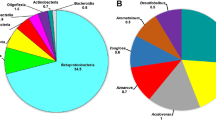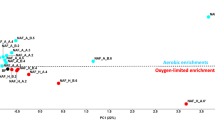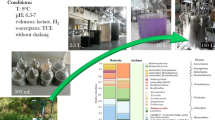Abstract
Effects of low temperature and low oxygen partial pressure on theoccurrence and activity of 2,3,4,6-tetrachlorophenol degrading bacteria in a boreal chlorophenol contaminated groundwater and a full-scale fluidized-bed bioreactor were studied using four polychlorophenol degrading bacterial isolates of different phylogenetic backgrounds. These included an α-proteobacterial Sphingomonas sp. strain MT1 isolated from the full-scale bioreactor and three isolates from the contaminated groundwater whichwere identified as β-proteobacterial Herbaspirillum sp. K1,a Gram-positive bacterium with high G + C content Nocardioides sp. K44 and an α-proteobacterialSphingomonas sp. K74. The Sphingomonasstrains K74 and MT1 and Nocardioides sp. K44 degraded2,4,6-trichlorophenol and 2,3,4,6-tetrachlorophenol as the solecarbon and energy sources. Close to stoichiometric inorganic chloride release with the 2,3,4,6-tetrachlorophenol removal andthe absence of methylation products indicated mineralization. Tetrachlorophenol degradation by the Herbaspirillum sp. K1 was enhanced by yeast extract, malate, glutamate, pyruvate, peptone and casitone. At 8 °C, Sphingomonas sp. K74 had the highest specific degradation rate(μmax = 4.9 × 10-12 mg h-1 cell-1) for 2,3,4,6-tetrachlorophenol. The Nocardioides strain K44 had the highest affinity (Ks = 0.46 mg l-1) for tetrachlorophenol. K1 and MT1 grew microaerophilically in semisolid glucose medium. Furthermore, the growth of MT1 was inhibited in liquidglucose medium at high oxygen partial pressure indicating sensitivity to accumulating toxic oxygen species. On the other hand, trichlorophenol degradation was not affected by oxygen concentration (2–21%). The isolates K44, K74 and MT1, with optimum growth temperaturesbetween 23 and 25 °C, degraded tetrachlorophenol faster at 8 °C than at room temperature indicating distinctly different temperature optima for chlorophenol degradation and growthon complex media. These results show efficient polychlorophenol degradation by the isolates at the boreal groundwater conditions, i.e., at low temperature and low oxygen concentrations. Differences in chlorophenol degradation and sensitivities to chlorophenols and oxygen among the isolates indicate that the phylogenetically different chlorophenol degraders have found different niches in the contaminated groundwater and thus potential for contaminantdegradation under a variety of saturated subsurface conditions.
Similar content being viewed by others
References
Altschul SF,Madden TL,Schäffer AA,Zhang J,Zhang Z,Miller W &Lipman DJ (1997) Gapped BLAST and PSI-BLAST: A new generation of protein database search programs. Nucleic Acids Res. 25: 3389–3402
Baldani VLD,Baldani JI,Olivares F &Döbereiner J (1992) Identification and ecology of Herbaspirillum seropedicae and the closely related Pseudomonas rubrisubalbicans. Symbiosis 13: 65-73
Baldani JI,Pot B,Kirchhof G,Falsen E,Baldani VLD,Olivares FL,Hoste B,Kersters K,Hartmann A,Gillis M &Döbereiner J (1996) Emended description of Herbaspirillum: inclusion of [Pseudomonas] rubrisubalbicans, a mild plant pathogen, as Herbaspirillum rubrisubalbicans comb. nov.; and classification of a group of clinical isolates (EF group 1) as Herbaspirillum species 3. Int. J. Syst. Bacteriol. 46: 802-810
Cote RJ &Gherna RL (1994) Nutrition and media. In Gerhardt P,Murray RGE,Wood WA &Krieg NR (eds) Methods for general and molecular bacteriology (p 160). American society for Microbiology, Washington D.C.
Döbereiner J (1992) The genera Azospirillum and Herbaspirillum. In Balows A,Trüper HG,Dworkin M,Harder W &Schleifer KH (eds) The prokaryotes, 2nd edn, Vol III (pp 2236-2253), Springer-Verlag, New York
Ederer MM,Crawford RL,Herwig RP &Orser CS (1997) PCP degradation is mediated by closely related strains of the genus Sphingomonas. Molecular Ecology 6: 39-49
Häggblom MM,Nohynek LJ,Palleroni NJ,Kronqvist K,Nurmiaho-Lassila EL,Salkinoja-Salonen MS,Klatte S &Kroppenstedt RM (1994) Transfer of polychlorophenol-degrading Rhodococcus chlorophenolicus (Apajalahti et al. 1986) to the genus Mycobacterium as Mycobacterium chlorophenolicum comb' nov. Int. J. Syst. Bacteriol. 44: 485-493
Häggblom MM &Valo RJ (1995) Bioremediation of chlorophenol wastes. In Young LY &Cerniglia C (eds) Microbial transformation and degradation of toxic organic chemicals (pp 390-434). Wiley-Liss Inc, New York
Järvinen KT,Melin ES &Puhakka JA (1994) High-rate bioremediation of chlorophenol-contaminated groundwater at low temperatures. Environ. Sci. Technol. 28: 2387-2392
Kitunen VH,Valo R &Salkinoja-Salonen MS (1987) Contamination of soil around wood-preserving facilities by polychlorinated aromatic compounds. Environ. Sci. Technol. 21: 96-101
Krieg NR &Hoffman PS (1986) Microaerophily and oxygen toxicity. Ann. Rev. Microbiol. 40: 107-130
Lampi P,Vartiainen T,Tuomisto J &Hesso A (1990) Population exposure to chlorophenols, dibenzo-p-dioxins and dibenzofurans after a prolonged groundwater pollution of chlorophenols. Chemosphere 20: 625-634
Langwaldt JH,Gueorgieva T &Puhakka JA (2000) Effects of ferrous iron and humic substances on aerobic in situ bioremediation of contaminated groundwater. In Hartmans S &Lens P (eds) Proceedings of the 4th International Symposium on Environmental Biotechnology (pp 166-169). Noordwijkerhout, The Netherlands
Männistö MK,Tiirola MA,Salkinoja-Salonen MS,Kulomaa MS &Puhakka JA (1999) Diversity of chlorophenol-degrading bacteria isolated from contaminated boreal groundwater. Arch. Microbiol. 171: 189-197
Männistö MK,Salkinoja-Salonen MS &Puhakka JA (2001) In situ polychlorophenol bioremediation potential of the indigenous bacterial community of boreal groundwater. Water Res. In press
Männistö MK &Puhakka JA (2001) Psychrotolerant and microaerophilic bacteria in boreal groundwater. FEMS Microbiol. Ecol. In press
McAllister KA,Lee H &Trevors JT (1996) Microbial degradation of pentachlorophenol. Biodegradation 7: 1-40
Melin ES,Järvinen KT &Puhakka JA (1998) Effects of temperature on chlorophenol biodegradation kinetics in fluidize-bed reactors with different biomass carriers. Water Res. 32: 81-90
Morita RY (1997) Bacteria in oligotrophic environments. Chapman & Hall, New York
Nohynek LJ,Nurmiaho-Lassila EL,Suhonen EL,Busse HJ,Mohammadi M,Hantula J,Rainey F &Salkinoja-Salonen MS (1996) Description of chlorophenol-degrading Pseudomonas sp. strains KF1T, KF3, and NKF1 as a new species of the genus Shingomonas, Sphingomonas subarctica sp. nov. Int. J. Syst. Bacteriol. 46: 1042-1055
Nohynek LJ,Suhonen EL,Nurmiaho-Lassila EL,Hantula J &Salkinoja-Salonen MS (1995) Description of four pentachlorophenol-degrading bacterial strains as Sphingomonas chlorophenolica sp. nov. Syst. Appl. Microbiol. 18: 527-238
Paul EA &Clark FE (1989) Soil microbiology and biochemistry. Academic Press. Inc., San Diego, CA
Poindexter, JS (1981) Oligotrophy fast and famine existence. Adv. Microb. Ecol. 5: 63-90
Puhakka JA &Melin ES (1996) Bioremediation of chlorinated phenols. In Crawford RL &Crawford DC (eds) Bioremediation, principles and applications (pp 254-299). Cambridge University Press, Cambridge, UK
Puhakka JA &Melin ES (1998) Chlorophenol-contaminated groundwater bioremediation at low temperatures. In Meyers RA (ed) The encyclopedia of environmental analysis and remediation (pp 1111-1120). John Wiley & Sons, Inc., New York
Puhakka JA,Järvinen KT,Langwaldt JH,Melin ES,Männistö MK,Salminen JM &Sjölund MT (2000) On-site and in situ bioremediation of wood preservative contaminated groundwater. Wat. Sci. Technol. 42: 371-376
Radehaus PM &Schmidt SK (1992) Characterization of a novel Pseudomonas sp. that mineralises high concentrations of pentachlorophenol. Appl. Environ. Microbiol. 58: 2879-2885
Resnick SM &Chapman PJ (1994) Physiological properties and substrate specificity of a pentachlorophenol-degrading Pseudomonas species. Biodegradation 5: 47-54
Staley JT (1968) Prosthecomicrobium and Ancalomicrobium: new prosthecate freshwater bacteria. J. Bacteriol. 95: 1921-1942
Wilson K (1990) Preparation of genomic DNA from bacteria. In Ausubel FM,Brent R,Kingston RE,Moore DD,Seidman JG,Smith JA &Struhl K (eds) Current protocols in molecular biology (pp 2.4.1-2.4.2). John Wiley & Sons, Inc., New York
Wittmann C,Zeng A-P &Decwer W-D (1998) Physiological characterization and cultivation strategies of the pentachlorophenoldegrading bacteria Sphingomonas chlorophenolica RA2 and Mycobacterium chlorophenolicum PCP-1. J. Indust. Microbiol. Biotechnol. 21: 315-321
Yoon J-H,Rhee S-K,Lee J-S.Park Y-H &Lee ST (1997) Nocardioides pyridinolyticus sp. nov., a pyridine-degrading bacterium isolated from the oxic zone of an oil shale column. Int. J. Syst. Bacteriol. 47: 933-938
Yoon J-H,Cho Y-G,Lee ST,Suzuki K-I,Nakase T &Park Y-H (1999) Nocardioides nitrophenolicus sp. nov., a p-nitrophenoldegrading bacterium. Int. J. Syst. Bacteriol. 49: 675-680
Zhulin IB,Bespalov VA,Johnson MS &Taylor BL (1996) Oxygen taxis and proton motive force in Azospirillum brasilense. J. Bacteriol. 178: 5199-5204
Author information
Authors and Affiliations
Rights and permissions
About this article
Cite this article
Männistö, M.K., Tiirola, M.A. & Puhakka, J.A. Degradation of 2,3,4,6-tetrachlorophenol at low temperature and low dioxygen concentrations by phylogenetically different groundwater and bioreactor bacteria. Biodegradation 12, 291–301 (2001). https://doi.org/10.1023/A:1014362508447
Issue Date:
DOI: https://doi.org/10.1023/A:1014362508447




